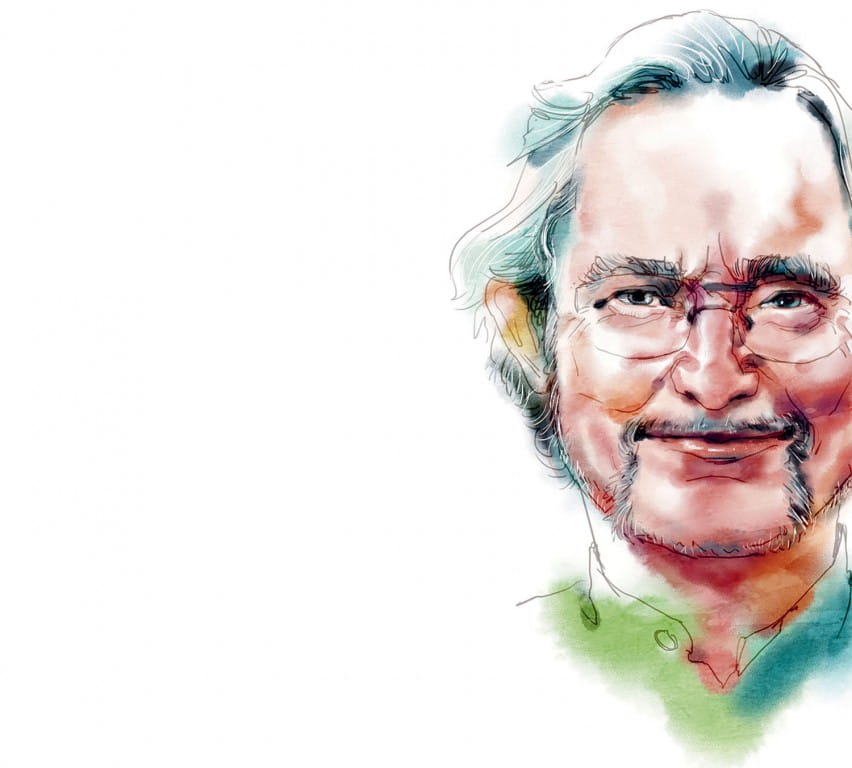
Archaeology professor John N Miksic has spent 30 years of his life unearthing Singapore’s past. Here, he shares insights from the 500 years of its pre-colonial history validated by his work.
BY LOW SHI PING
ILLUSTRATION KEN LEE
ingapore was not a sleepy fishing village before its founding by Sir Stamford Raffles in 1819 as a British colony. In fact, Singapore was a bustling trading port in the mid-14th century, some 500 years before the British arrived. Back then, its multi-ethnic population, made up of Malays, Indians, Chinese and other races, had reached a peak of 10,000.
This uncovering of Singapore’s pre-colonial history has been so significant that a new lower-secondary history syllabus, providing further details on the country’s links to the Malay Archipelago long before it was colonised, was introduced in schools in 2014.
The man responsible for this discovery is John N Miksic, 69, an American archaeology professor at the Department of Southeast Asian Studies at the National University of Singapore (NUS). Since 1984, Prof Miksic has conducted 24 excavations at 10 different sites around the Civic District of Singapore, including landmarks such as Fort Canning, Empress Place and St Andrew’s Cathedral.
His digs have unearthed eight tonnes of artefacts, from Chinese ceramics to gold jewellery and carnelian beads from India.
REGIONAL LINKS
Key among his findings is that, as far back as the 1300s, Singapore was part of a network of early ports in South-east Asia. Its ancient city centre near the Singapore River was demarcated by a brick wall and mentioned by Raffles himself in his letters. The economy then was based on trade and the processing of imported raw materials such as copper and gold.
“The people who lived here weren’t just pirates and fishermen. They had a fair number of different occupations,” says Prof Miksic, who holds a doctorate in anthropological archaeology from Cornell University.
His archaeological digs have led him to conclude that different parts of the city served different functions. For instance, the area around Parliament House was reserved for copper working, while Empress Place, with its rows of warehouses, was a trading zone.
“The inhabitants also had sophisticated taste in Chinese ceramics,” he says, citing the example of a porcelain pillow, which was found on Fort Canning. It is sculpted like a theatre set and dates to the period between 1280 and 1350.
“I have visited many other cities, both in America and around the world, and would never want to live in any other city except Singapore.”
Professor John N Miksic
Another noteworthy find, he says, is the statue of the Headless Horseman, unearthed at Empress Place, which dates back to the same period as the porcelain pillow.
“This is the only known lead statue from South-east Asia, done in a style only known from stone carvings and paintings, suggesting that Singapore had important connections with Java and Sumatra,” he explains.
Through his work, he hopes Singaporeans will appreciate the fact that their country’s roots are far older than the arrival of the British in 1819, and it is not “an accidental creation” of the Europeans.
“This would emphasise the Asian roots of the country, and provide a firmer, more stable foundation for the long-term development of a uniquely Singaporean identity,” says Prof Miksic, who moved to Singapore in 1987.
He had been offered a job teaching pre-colonial South-east Asian history at NUS, and has never left.
In fact, since his first visit to the region in 1968 volunteering with the Peace Corps, his fascination and curiosity towards the region’s rich history has remained unabated, leading him to start projects in Indonesia, Cambodia, Myanmar and of course, Singapore. “Back in the 1960s and ‘70s, nobody was doing anything relating to archaeology in South-east Asia. It was a big blank; that’s why I interested in it,” he says.
CONTINUING LEGACY
After nearly three decades in Singapore, he has grown attached to the place and its people. He says: “I have visited many other cities, both in America and around the world, and would never want to live in any other city except Singapore; I’ve gotten spoiled by the general cleanliness of the place and the friendliness of its people.”
He names Singaporeans’ awareness of the rest of the world and interest in experiencing other cultures, their consciousness of social responsibility and the virtues of community involvement, and their general courtesy as some of the things he appreciates.
Having made a name for himself as Singapore’s archaeologist, he is concerned that nobody will continue his work after he retires, which is why he is working fervently on compiling a database of all the artefacts found during his research in Singapore. “This will provide a resource for future scholars to work on,” he says.
More pertinently, to make it possible to establish a long-term research programme on the impact of maritime trade and Chinese migration on pre-colonial South-east Asia, he is raising funds for an endowment to set up a permanent archaeology laboratory at NUS.
He says: “Much attention has been focused on the relations between India and South-east Asia in ancient times, but the South-east Asia-China link is much less studied. I would like to continue to work with scholars in other parts of South-east Asia to develop a regional project that focuses on this topic.”
